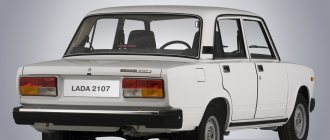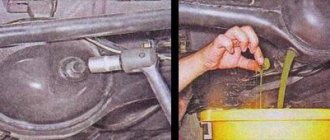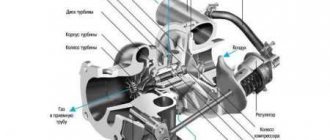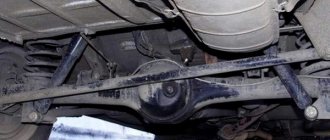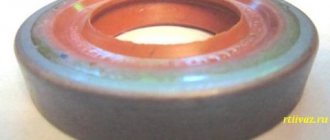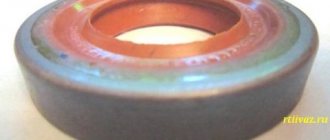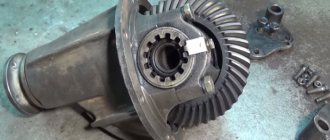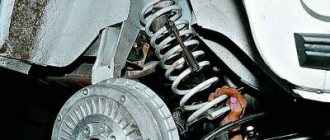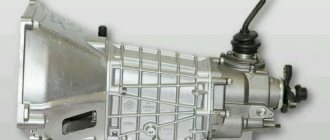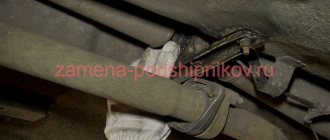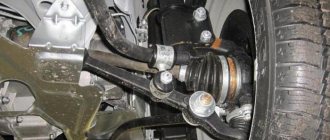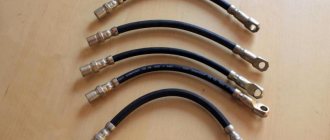All VAZ classic cars are rear-wheel drive, the vehicle moves using the rear axle, which is the drive axle. The VAZ rear axle gearbox is the most important part in the transmission; it is where the main gear is located.
- 1 Device
- 2 Differences in VAZ rear axle gearboxes
- 3 Gearboxes on machine 2107
- 4 Replacing the rear axle gearbox of VAZ 2106, 2107
- 5 Defects in the gearbox
- 6 Adjusting the VAZ rear axle gearbox
- 7 Repair or replacement, which is better
- 8 Locking the VAZ rear axle gearbox
A lot depends on the gearbox - if it is faulty and humming, the car can get stuck in the middle of the road at any moment and will have to be towed. The speed of the car depends on the gear ratio (TR) of the main pair in the rear axle gearbox (REA) - the lower it is, the faster the car will move. But too high a speed loads the engine and transmission, so when replacing REM, owners of VAZ 2101-07 vehicles must take into account the power and volume of the internal combustion engine (ICE), and install a gearbox that optimally matches the technical characteristics of the vehicle.
Design and operation of the rear axle
The rear axles of VAZ-2101, -2102 cars and their modifications have the same design and are completely unified, with the exception of gearboxes, the main gear of which has a different gear ratio.
For the VAZ-2101 and its modifications it is 4.3, and for the VAZ-2102 it is 4.44. To distinguish gearboxes for station wagons, the letter “U” is applied to their neck. A gearbox is attached to the housing (beam) 18 (Fig. 79) of the rear axle, in which the main gear and differential are located. The driving 32 and driven 41 gears of the main gear are paired in terms of contact and noise, so if one of them is damaged, both are replaced. Between the inner rings of bearings 23 and 29 of the drive gear there is a spacer sleeve 30, which, deformed when the drive gear nut is tightened, provides preload in the bearings.
An adjusting ring 31 is installed between the end of the drive gear and the inner bearing, which determines the correct position of the drive gear relative to the driven gear.
The driven gear of the main gear is attached to the flange of the differential box 22, which rotates on two bearings 46. The preload in these bearings, as well as the gap between the teeth of the drive and driven gears, is adjusted by nuts 47, wrapped in split bearing beds. The semi-axial gears 40 are installed in the cylindrical slots of the differential box and rest on the box through support washers 42. By selecting the washers according to their thickness, a lateral gap of 0.0-0.1 mm is established between the teeth of the satellites and the semi-axial gears.
Axle shaft 2 with its inner end enters the spline hole of the semi-axial gear, and with its outer end it rests on a ball bearing 16, which is secured to the axle shaft with a locking ring 7. The axle shaft bearing is sealed in the socket of the bridge beam on the inside with a self-clamping oil seal 17, and on the outside with a rubber ring. The bearing is secured in the beam seat by a plate 8, which, together with the oil deflector 6 and the brake shield 1, is secured with four bolts to the beam flange 15.
The dimensions of the main mating parts and the limits of permissible wear during operation are given in table. 12.
Bridge VAZ 2101
The rear axle is one of the main elements of the VAZ 2101 transmission. It is designed to transmit torque from the driveshaft to the axle shafts of the vehicle, as well as to evenly distribute the load on the wheels while driving.
Specifications
The drive axles of VAZ cars of the 2101–2107 series are unified. Their design and characteristics are completely identical, with the exception of the gear ratio. For a “kopeck” it is 4.3. VAZ station wagon models (2102, 2104) were equipped with gearboxes with a gear ratio of 4.44.
Table: main characteristics of the rear axle of the VAZ 2101
Higher or lower?
Often, owners of classic Zhiguli cars use replacing the main pair as one of the types of tuning their cars. Which gearbox should I put on the VAZ-2107? It is worth choosing the gear ratio based on the engine power. If you install a pair with a low ratio (for Zhiguli the maximum parameter is 3.9), it will be easier for the car to accelerate to maximum speed. But in the range of 0-100 kilometers per hour, it will lose significant time for acceleration.
If the motor has not been modified, it is better to install a gearbox with a “4.4” ratio. The car will accelerate faster to one hundred kilometers per hour, but it will not go higher than this speed or will pick it up very slowly. Therefore, adjusting the gear ratios is not the only modification for the “seven”. In addition, the motor itself will have to be modified.
vote
Article rating
Rear axle device
The design of the rear axle of the VAZ 2101 consists of two main elements: a beam and a gearbox. These two nodes are combined into one mechanism, but they perform different functions.
What is a beam
The beam is a structure of two stockings (casings) rigidly connected by welding. Flanges are welded into the ends of each of them, designed to accommodate semi-axial oil seals and bearings. The ends of the flanges have four holes for installing brake shields, oil deflectors and plates that press the bearings.
The middle part of the rear beam has an extension in which the gearbox is located. In front of this extension there is an opening closed by the crankcase.
Half shafts
The machine's axle shafts are installed in stockings. At the inner ends of each of them there are splines with which they are connected to the semi-axial gears of the gearbox. Their uniform rotation is ensured by ball bearings. The outer ends are equipped with flanges for mounting the brake drums and rear wheels.
Gearbox
The gearbox design consists of a main gear and a differential. The role of the device is to evenly distribute and redirect the force from the driveshaft to the axle shafts.
main gear
The main transmission mechanism includes two bevel gears: drive and driven. They are equipped with spiral teeth that ensure they are connected at right angles. Such a connection is called hypoid. This design of the main gear can significantly improve the grinding and running-in process of gears. In addition, maximum noiselessness is achieved during gear operation.
The main transmission gears of the VAZ 2101 have a certain number of teeth. The drive has 10, and the driven has 43. The ratio of the number of their teeth determines the gear ratio (43:10 = 4.3).
The driving and driven gears are selected in pairs on special machines in the factory. For this reason, they are also sold in pairs. In case of gearbox repair, replacement of gears is allowed only as a set.
Differential
The center differential is necessary to ensure that the wheels of the vehicle rotate at different speeds depending on the load on them. The rear wheels of a car do not travel the same distance when turning or overcoming obstacles in the form of holes, potholes, or ledges. And if they were rigidly connected to the gearbox, this would lead to constant slippage, causing rapid tire wear, additional stress on transmission parts, and loss of contact with the road surface. The listed problems are solved using a differential. It makes the wheels independent of each other, thereby allowing the car to freely turn or overcome various obstacles.
The differential consists of two side gears, two satellite gears, adjusting washers and a cast iron box that acts as a housing. The axle shafts fit into the axle gears with their splines. The latter rest on the internal surfaces of the box using adjusting washers of a certain thickness. They do not contact each other directly, but through satellites that do not have a rigid fixation inside the box. While the car is moving, they move freely around their axis, but are limited by the surface of the driven gear, which prevents the axis of the satellites from moving from the mounting sockets.
The differential housing with the mechanism is installed inside the gearbox on roller bearings pressed onto the housing support journals.
Malfunctions of the rear axle of the VAZ 2101 and their symptoms
The complexity of the rear axle design does not in any way affect its performance or service life. If all the parts are selected accurately, the unit systematically undergoes appropriate maintenance, and the car has not been involved in traffic accidents, it may not declare itself at all. But it also happens the other way around. If you do not pay due attention to the bridge and ignore possible signs of its malfunction, problems will definitely appear.
Signs of failure of the “penny” rear axle
The most likely symptoms that your vehicle's axle is faulty are:
- oil leak from the gearbox or axle shafts;
- lack of transmission of torque from the “cardan” to the wheels;
- increased noise level in the lower rear part of the car;
- noticeable vibration when moving;
- uncharacteristic noise (hum, crackling) when accelerating the car, as well as when braking the engine;
- knocking, crackling from the side of the bridge when entering a turn;
- crunch at the beginning of movement.
Failure of the rear axle of VAZ 2101
Let's consider the listed symptoms in the context of possible malfunctions.
Oil leak
Let's start with the simplest thing - lubricant leaks. This is probably the most common problem that owners of “kopecks” face. A timely detected leak does not pose any threat to the unit, however, if the oil level reaches a critical minimum, rapid wear of the main gears, axle shafts and stellites is inevitable.
Lubricant from the rear axle of the “penny” may leak from under:
- a breather, which serves as a kind of pressure valve;
- oil filler plugs;
- drain plug;
- shank oil seal;
- gearbox flange gaskets;
- axle seals.
Lack of transmission of torque from the driveshaft to the wheels
Unfortunately, such a malfunction is also not uncommon. Most often it occurs due to low quality parts or manufacturing defects. The breakdown is characterized by the lack of reaction of one or both rear wheels when the “universal shaft” rotates normally. If you have to face such a situation, you can safely prepare to replace the axle shaft. Most likely, it simply burst.
Increased noise level in the bridge area
Strong noise from the bridge while driving may indicate such malfunctions as:
- loosening of the fastening of the wheel rims to the axle shafts;
- wear of axle shaft splines;
- failure of semi-axial bearings.
Vibration
Vibration in the rear of the vehicle while driving can be caused by deformation of the shaft of one or both axle shafts. Similar symptoms also occur due to deformation of the beam.
Noise when accelerating or braking
A hum or crackling sound that occurs when accelerating a car, as well as during engine braking, is usually a sign of:
- insufficient amount of lubrication in the gearbox;
- wear of the mechanism bearings or improper tightening;
- failure of semi-axial bearings;
- exhaustion or incorrect adjustment of the distance between the main gear gears.
Knocking or rattling noise when turning
Extraneous sounds in the area of the rear axle during cornering may occur due to:
- occurrence of chips and scuffs on the surface of the satellite axis;
- wear or damage to satellites;
- increasing the distance between gears due to their wear.
Crunching sound at the start of movement
A crunching sound when starting the car may indicate:
- wear of the satellite axis mounting sockets;
- shank play;
- change in the gap in the connection between the drive gear and the flange.
Defects in the gearbox
Increased play in the RZM can be formed due to wear of the differential pinion pin - if you grab the driveshaft and rotate it clockwise and counterclockwise, this play can be felt. Also, increased clearance may occur due to wear of the splines inside the differential housing.
If the gaps in the main pair of gearboxes are not adjusted, a characteristic noise occurs when the car moves:
- when the load increases (sharp acceleration), a characteristic howl is heard in the bridge;
- When I let off the gas the noise goes away.
The engine can hum in a different way, but the characteristic feature described above can most often be heard on VAZ classic cars. Worn teeth of the main pair are clearly visible on the planetary gear - they become rounded, and they often show traces of rust.
How to check the rear axle
Naturally, noises such as hum, vibration, crackling or knocking can also occur due to other malfunctions. For example, the same driveshaft, if the outboard bearing breaks or the crosspiece fails, can make a crunching sound and vibrate. Failure of the elastic coupling of the universal joint is also accompanied by similar symptoms. The rear struts or other suspension elements may be knocking. In any case, before starting to repair the bridge, it is important to make sure that it is the one that is faulty.
Checking the rear axle is performed as follows:
- We drive out onto a flat section of the road without holes or ledges.
- We accelerate the car to 20 km/h.
- We listen and note the accompanying noises.
- We gradually increase the speed of the car to 90 km/h and remember at what speed this or that uncharacteristic sound occurs.
- Without turning off the gear, release the accelerator pedal, reducing the engine speed. We continue to monitor changes in the nature of the noise.
- Again we accelerate to 90–100 km/h, turn off the gear and ignition, letting the car coast. If the extraneous noise does not disappear, the rear axle gearbox is in order. Without load, it cannot make noise (except for the bearings). If the sound disappears, the gearbox is probably faulty.
- We check the tightness of the wheel bolts by tightening them with a wheel wrench.
- We install the car on a horizontally flat surface. We hang its rear wheels with a jack so that we can rotate them freely.
- We alternately rotate the wheels of the car left and right, and also push them back and forth to determine the play. The wheel should turn easily without jamming. If the wheel plays or slows down when the bolts are securely tightened, the axle bearing is most likely worn out.
- When the gear is engaged, we rotate each of the wheels around its axis. Let's look at the behavior of the cardan shaft. It should also spin. If it doesn't turn, the axle shaft is most likely broken.
Video: extraneous noises in the rear of the car
Repair of the rear axle of VAZ 2101
The process of repairing the rear axle is a rather labor-intensive task that requires certain skills and special equipment. If you do not have sufficient experience and the necessary tools, it is better to contact a car service.
Replacement of axle shafts, their bearings and seals
To replace a deformed or broken axle shaft, its bearing, and oil seal, you will need to dismantle the wheel and partially disassemble the beam. Here we will need:
- car jack;
- wheel bolt wrench;
- car body stand;
- wrenches “8” (“12”) and “17”;
- flat screwdriver;
- round nose pliers or pliers;
- hammer;
- large chisel;
- “grinder” with the ability to connect to the electrical network;
- gasoline blowtorch or gas burner;
- vice;
- grease.
In addition, you will also need the spare parts themselves that are planned to be replaced, namely the axle shaft, bearing, lock ring, oil seal. The table below shows the catalog numbers and characteristics of the necessary parts.
Installation
A serviceable bearing should be checked for grease. If it is not there, which is sometimes done by unscrupulous manufacturers, you will need to lubricate the part yourself. Insert using a pipe, carefully hitting it with a hammer.
The stopper must be heated to a uniform gray color. Using pliers, place it on the base so that the widened part is directed upward. The ring is also pressed tightly into the pipe and quickly lubricated for cooling. It is appropriate at this stage to replace the oil seal. Using a pry bar, the old one is knocked out. The installation is done with a hammer and a socket number 32. At this point, the installation of the new bearing is completed, and the axle shaft is ready to “return” to the rear axle of the car.
Gearbox and rear axle of the classic VAZ 2107 2106 2101 2105
It would seem that nothing can be improved on the classic vases. However, there are 3 options for gearboxes and 4 rear axle gearboxes. The gearboxes come in 2101, 2105, 2106. The gears (1st, 2nd, 3rd) in 2101 are shorter than in 2105, and longer in 2106. Gearboxes come with gear ratios of 3.9, 4.1, 4.3, 4.44. How to find out the gear ratio? Raise the rear wheel, put it in neutral, make 10 revolutions of the wheel and count the revolutions of the cardan.
Cardan speed
What does the gear ratio give? The higher it is, the lower the speed in all gears at the same speed. On standard sixes with a 1500 engine, a 2105 gearbox and a 4.1 axle are installed at the factory. If the engine is 1600, then the gearbox is original (2106), the axle is 3.9 or 4.1.
Let's assume that all cars have 175/65R13 tires. Let's now look at the graph of the dependence of the car's speed on the engine speed (always on the graphs the standard 1500 with a 2105 gearbox and a 4.1 axle will be indicated in green. Why - because there are more of them than all the others).
With a 2106 gearbox and a standard 4.1 axle (raspberry) with a standard engine, we get a gain in dynamics only due to the long 1st gear, the 2.3 has become longer, which is not good (with a standard engine).
If the engine is boosted, then long gears are what you need: maximum power will be delivered over a wider speed range without compromising dynamics. For example, let’s take gearbox 2106 and gearbox 3.9 (raspberry):
Here all the gears are longer (especially the first). For example, in our version in first gear the speed range of 3500-6500 is at a speed of 28-53 km/h, and in the standard it is at 25-45 km/h. Feel the difference! By the way, in this configuration, the first, second, third gears completely coincide with the 11th row on the chisels (with a 3.7 axle), the fourth is shorter, and if the fifth, then it is not much longer than the chisel fourth gear... truly, everything new is well forgotten old :).
Another thing is if we install a 4.44 bridge (raspberry):
Compare: 1-longer ? 2,3-shorter, 4-short!! That is, from a traffic light in first gear, we rev up the engine when the “standard” is already shifting to 2, then second, third, fourth, and we go forward. This option is optimal for a standard engine. However, there is a minus: in 4th gear, already at 140 km/h the revolutions will be 6000... here it is better to use standard 5th gear, which will create a complete picture. Here you have the highway, and the city - and the wolves are fed up and no one was hurt. And due to the fact that at maximum speed modes the revolutions will be close to maximum, the dynamics on the track will be amazing.
That is, with a standard 1500 or 1600 engine, tuning the gearbox and gearbox is as follows: Option 1 - install a 2106 gearbox with 5th gear. — Install gearbox 2102 (4.44).
And if the engine is boosted, then there is option 2: - gearbox 2106. - Gearbox 3.9 Or 1st, if you want to tear everyone around the city.
Change of oil
Having previously prepared all the necessary tools, you can start changing the oil. First, let's look at the engine.
Note! It is best and most convenient to change oils in an inspection pit or on an overpass. This will ensure the best access to all necessary units
Changing the oil in the VAZ 2106 engine
As you know, oil needs to be changed at certain intervals. For the engine it is as follows: after a major overhaul - after 1000 km, it is necessary to change the oil and then every 10,000 kilometers of the vehicle. How to change the engine oil (see VAZ 2106: changing the engine oil and oil filter)? It’s very simple – drain and refill. This is short.
Detailed instructions below:
To drain the oil, you need to unscrew the drain plug in the engine sump. It is unscrewed using a 12mm hex and a wrench (for convenience).
Note. The oil must be changed when the car is warm. To avoid scalding your hands, you can use special rubber gloves.
Unscrew the plug and at the same time place a container under the drain hole. After the oil has drained, you can tighten the plug back.
Next, you should replace the oil filter. The old one can be twisted by hand if possible. If they are tightened well, then you should use a special puller. After removing the old filter, the new one is simply screwed into the hole.
- After this, unscrew the filler cap, which is located on the engine valve cover, by hand. Then insert a watering can of suitable diameter into the neck.
- Gradually add oil. Periodically you should look at the level of oil remaining in the canister. Approximately 3.7 liters of oil must be filled into the engine.
The amount of oil poured is determined using the oil dipstick. You need to take it out, wipe it clean with a rag, put it back in and then pull it out again and look at the marks. The oil level should be approximately halfway between the two marks.
Note. Do not fill oil until about! Too much oil in the engine will put excess stress on the seals and, accordingly, the oil will leak faster.
- After reaching the desired mark, tighten the plug.
- Then you should start the car engine. The “oil pressure” light should immediately light up on the instrument panel. After a few seconds of engine operation, the light will go out. The engine should run for several minutes.
- After running the engine for several minutes, turn it off and measure the oil level again. If necessary, it should be topped up.
Some may argue that it is necessary to change the oil first with flushing oil, and then fill in a new one. But, as practice shows, this is not necessary. After changing the oil, you should check whether the drain plug in the engine sump is tightly tightened to avoid leakage.
Changing the oil in the VAZ 2106 gearbox
Changing the oil in a VAZ 2106 gearbox is not fundamentally very different from replacing it in an engine (see Changing the oil in a VAZ 2106 gearbox yourself).
Frequency of oil changes in the gearbox: usually 30-40 thousand km. mileage. Opinions differ on this issue, but on average the data is as follows.
So:
- Drain the oil from the gearbox housing. Use a 12mm hex to unscrew the drain plug and drain the oil into a previously prepared container.
- We tighten the drain plug with the same hexagon.
- Next, using a 17mm wrench, unscrew the filler cap of the gearbox housing.
- Using a special or homemade syringe, fill in the required amount of oil. Oil is filled to the level - that is, until it flows from the filler hole.
- Then the plug is screwed on.
- The gearbox housing is wiped and inspected for oil leaks.
Advice. If metal dust or, even worse, metal shavings were found in the oil drained from the box, then the gearbox must be repaired!
A four-speed gearbox requires 1.4 liters of oil, and a 5-speed gearbox requires 1.6-1.7 liters. Thus, changing the oil in the VAZ 2106 gearbox is completed.
Changing the oil in the rear axle gearbox on a VAZ 2106
So:
Unscrew the drain plug with a 12mm hexagon.
- Drain the oil into a container.
- We tighten the drain plug.
- Unscrew the filler plug with a 17 wrench.
- Using a syringe, fill in 1.3 liters of oil until it flows out of the filler hole.
- Tighten the filler plug tightly.
The oil in the rear axle gearbox has been replaced!
Operating principle of the rear axle
The rear axle is used to transmit torque in a car from the engine, through the gearbox, through a cardan transmission to the rear axle, final drive, differential, axle shafts to the driving wheels of the car.
These components and parts are located in the rear axle of the car, which consists, respectively, of two main parts: a hollow beam (includes two stamped casings welded together) and a housing, a rear axle gearbox.
The rear axles of VAZ 2101-2107 cars have almost the same design and can be said to be unified among themselves. The exception is rear axles in all-wheel drive vehicles and front-wheel drive VAZ vehicles (and their modifications).
Change of oil
Note
The oil should be changed immediately after a trip; hot oil drains faster and more completely, along with the particles suspended in it. Attention! Be careful - oil temperature can reach 90°C
1. Unscrew the filler plug (see above).
2. Place a container with a volume of at least 1.5 liters under the drain hole.
12mm hex wrench
unscrew the drain plug.
4. Drain the oil.
The drain plug is equipped with a magnet that attracts wear products from the gearbox parts.
5. Clean the plug and install it in place.
Note. If the drained oil is dark and metal particles are clearly visible in it, it is recommended to flush the gearbox.
To do this, pour approximately a liter of low-viscosity oil (for example, spindle oil) into the bridge. Having hung one of the rear wheels (see “Preparing the car for maintenance and repair”), start the engine and engage first gear. After five minutes, turn off the engine, drain the oil, clean it again and tighten the drain plug.
6. Fill the bridge with fresh transmission oil to the level of the filler hole and tighten the plug.
7. Clean the outside of the breather with a brush or rag. We turn the breather cap several times to clean its channel.
Many VAZ 2106 owners neglect to change the oil in the rear axle of the car, thinking that it is not necessary to do this. But if you want to extend the life of your car, then it is better to perform this procedure twice a year. Why should you follow this recommendation? The fact is that the viscosity of the oil being poured should be different in summer and winter:
- In winter it is necessary to fill in thinner oil
- in summer, on the contrary, it is more viscous
The replacement procedure itself is quite simple and to perform it you will need the following tool:
- Hexagon
- 17mm head with crank or ratchet handle
- Funnel and small hose (special syringe)
This procedure must be carried out either in the pit, or simply by lifting the rear part with a jack. It is worth noting that it is better to carry out this work after the trip, so that the oil is more fluid and drains from the gearbox without any residue.
So, unscrew the plug with a hexagon, as shown in the photo below:
After this, wait a few minutes until all the used oil drains from the rear axle. Of course, you will need to substitute the container:
After draining, screw the plug back in and unscrew the top one to gain access to the rear axle filler hole:
And after that you can fill in new gear oil. Personally, I used a funnel connected to a hose for this, something like how it all looks in the picture below:
If you noticed, the whole procedure is shown using the Niva as an example, but there is no difference. The only thing is that it is best to use a special syringe for filling the VAZ 2106. As for the level and volume, you need to fill until the oil reaches the extreme edge of the filler hole.
After completing the procedure, you should also clean the breather, which is located on top of the “stocking” in the center, from dust and other formations. Now you can screw the filler plug into place and consider the procedure completely completed. Do not forget that gear oil should be used for the gearbox in accordance with the temperature conditions, that is, the time of year!
